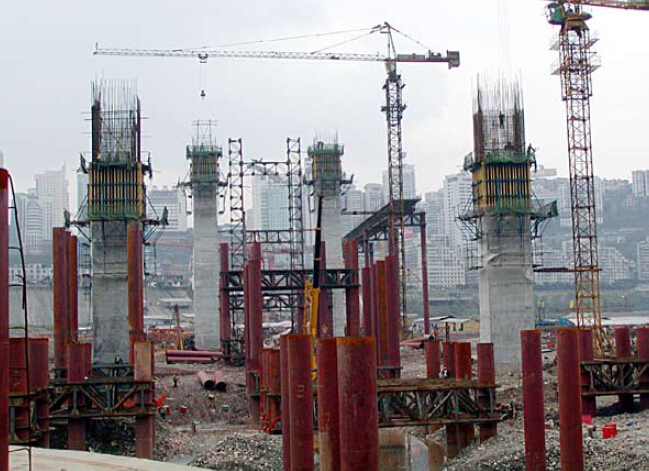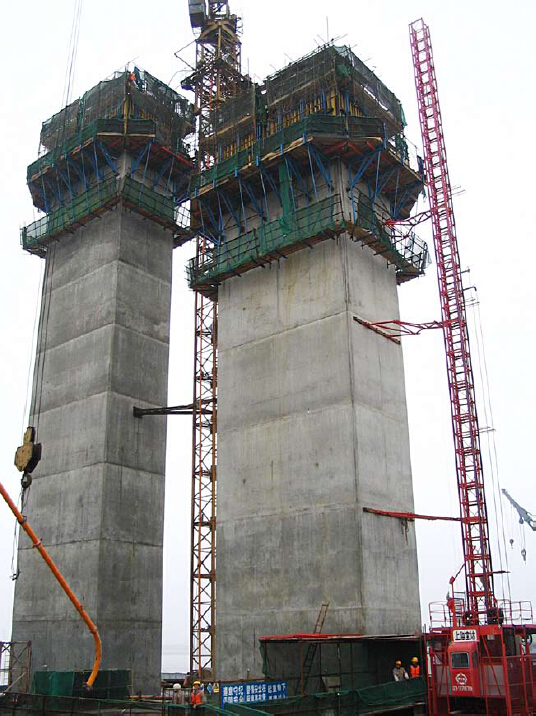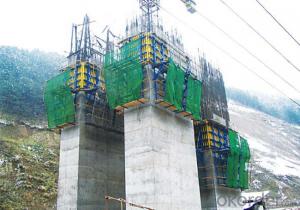Climbing bracket CB-240 for formwork and scaffolding system
- Loading Port:
- Tianjin
- Payment Terms:
- TT OR LC
- Min Order Qty:
- 50 m²
- Supply Capability:
- 1000 m²/month
OKorder Service Pledge
OKorder Financial Service
You Might Also Like
Climbing Bracket CB240 & CB210
They are framework brackets for supporting large-area wall formwork.
Typical applications for the CB240&CB210 are pier and column/shear wall/core walll/ in the
building.
CB210 has smaller size than CB240, it will be cost effective in some condition.
Characteristics:
◆ High bearing capacity
The high loading capacity of the brackets allow very large scaffold units. This saves the number
anchor points required as well as reducing climbing times.
◆ Simple moving procedure by crane
Through the strong connection of formwork together with the climbing scaffold, both can be moved
as a single climbing unit by crane. Thus valuable time-savings can be achieved.
◆ Fast striking process without a crane
With the retrusive set, large formwork elements can also be retracted quickly and a minimum of
effort.
◆ Safe with work platform
The platforms have assembled firmly with bracket and will be climbing together, without scaffolding
but can work safely in spite of your high location.


- Q: How does steel formwork handle different concrete surface texture requirements?
- Steel formwork is a versatile and durable option that can handle a variety of concrete surface texture requirements. With its adjustable and customizable design, it allows for different surface finishes to be achieved. One way steel formwork meets different concrete surface texture requirements is by being easily modified and adapted. By adjusting the steel formwork panels, various finishes such as smooth, textured, or patterned concrete can be accommodated. This flexibility makes it suitable for a wide range of construction projects, from simple slabs to complex structures. Additionally, steel formwork ensures a smooth and consistent surface, which is crucial for achieving the desired concrete finish. The rigid and sturdy nature of steel prevents any distortions or imperfections from occurring during the pouring and curing process, resulting in a uniform surface texture, regardless of the design's complexity. Moreover, steel formwork offers excellent resistance to wear and tear, making it suitable for projects that require repetitive use or high-volume concrete pouring. Its durability allows it to maintain its shape and integrity even after multiple uses, ensuring consistent concrete surface texture requirements are met over time. In conclusion, steel formwork is a reliable and adaptable solution for addressing various concrete surface texture requirements. Its adjustability, durability, and ability to provide a smooth and consistent surface make it an ideal choice for achieving different finishes, regardless of the project's complexity.
- Q: What are the different types of safety systems used with steel formwork?
- There are several types of safety systems used with steel formwork, including guardrails, safety nets, edge protection systems, fall arrest systems, and personal protective equipment (PPE). These systems are designed to prevent falls, provide barriers against hazardous areas, and protect workers from potential accidents or injuries while working with steel formwork.
- Q: How does steel formwork affect the overall cost of a construction project?
- Steel formwork can have a significant impact on the overall cost of a construction project. Although the initial cost of steel formwork may be higher than other types of formwork, it offers several advantages that can lead to cost savings in the long run. Firstly, steel formwork is highly durable and can be used repeatedly, making it a cost-effective option for multiple construction projects. Unlike other formwork materials such as wood, steel does not warp or degrade over time, reducing the need for costly replacements or repairs. Additionally, steel formwork provides enhanced structural stability, ensuring accurate and precise concrete placement. This results in reduced material wastage and a more efficient use of resources, ultimately lowering construction costs. Moreover, steel formwork offers faster assembly and disassembly times compared to traditional formwork materials. The quick installation and removal process can significantly reduce labor costs and the overall duration of the project, allowing for increased productivity and potentially saving on overhead expenses. Furthermore, steel formwork is highly adaptable and customizable to different project requirements. Its versatility enables it to be used in various construction applications, such as forming complex shapes and designs. This flexibility reduces the need for specialized formwork systems, which can be expensive, and allows for cost-effective solutions tailored to specific project needs. Lastly, steel formwork is known for its excellent quality and precision, resulting in higher-quality concrete finishes. This can eliminate the need for additional finishing work, such as plastering or leveling, which can be costly and time-consuming. In conclusion, while the initial cost of steel formwork may be higher than alternative materials, its durability, structural stability, faster assembly times, adaptability, and high-quality finishes can lead to significant cost savings throughout the construction project. Therefore, considering the long-term benefits and cost-effectiveness of steel formwork is crucial when evaluating the overall cost of a construction project.
- Q: How does steel formwork contribute to the overall fire safety of the building?
- Steel formwork can contribute significantly to the overall fire safety of a building due to its inherent properties and characteristics. Firstly, steel formwork is known for its high fire resistance. Steel has a high melting point and does not ignite or burn easily, making it a suitable material for construction in areas prone to fire hazards. In the event of a fire, steel formwork remains structurally stable, providing a crucial barrier that helps to contain the fire and prevent its spread to other parts of the building. This can be especially important in high-rise buildings, where fire safety is of utmost importance. Additionally, steel formwork is non-combustible, meaning it does not release flammable gases or toxic fumes when exposed to fire. This is crucial for the safety of occupants, as smoke inhalation and toxic gases are significant causes of casualties in fire incidents. By using steel formwork, the risk of smoke and toxic gases spreading throughout the building is minimized, allowing occupants more time to evacuate safely. Moreover, steel formwork is a durable and robust material, capable of withstanding the impact of fire and retaining its structural integrity. This is crucial in ensuring the stability of the building during a fire, as it prevents collapse and reduces the risk of injuries or fatalities. Steel formwork can also resist the effects of high temperatures, such as thermal expansion, which can further contribute to the fire safety of the building. In conclusion, steel formwork plays a vital role in enhancing the overall fire safety of a building. Its high fire resistance, non-combustible nature, and durability contribute to containing fires, minimizing the spread of smoke and toxic gases, and maintaining the structural integrity of the building. By incorporating steel formwork in construction, the risk of fire-related incidents and the potential consequences can be significantly reduced, ensuring the safety of occupants and property.
- Q: How does steel formwork perform in high-temperature conditions?
- Steel formwork performs well in high-temperature conditions due to its inherent strength and heat resistance properties. Steel is known for its high melting point and can withstand high temperatures without losing its structural integrity. This makes it an ideal choice for construction projects that are exposed to extreme heat or fire hazards. In high-temperature conditions, steel formwork maintains its shape and stability, ensuring that the concrete structure being formed remains intact. It does not warp, deform, or weaken under the influence of heat, providing a reliable and safe solution for concrete formwork. Moreover, steel formwork has excellent thermal conductivity, allowing it to dissipate heat efficiently. This prevents the build-up of excessive heat within the formwork, minimizing the risk of thermal expansion or damage to the concrete during curing. Additionally, steel formwork is highly durable and can withstand prolonged exposure to high temperatures without deterioration. It is resistant to corrosion, which further enhances its performance in high-temperature environments. This durability ensures that steel formwork can be reused multiple times, making it a cost-effective and sustainable option for construction projects. Overall, steel formwork is a reliable and efficient choice for high-temperature conditions. Its strength, heat resistance, and durability make it an ideal solution for concrete formwork, providing a stable and secure platform for construction activities even in extreme heat.
- Q: How does steel formwork affect the overall aesthetics of a structure?
- Steel formwork can have a significant impact on the overall aesthetics of a structure. Unlike traditional wooden formwork, steel formwork provides a smooth and sleek finish to the concrete, resulting in a more visually appealing appearance. The use of steel formwork allows for precise and accurate shaping of the concrete, ensuring that the structure has clean lines and smooth surfaces. Furthermore, steel formwork enables architects and designers to create complex and intricate designs that would be difficult to achieve with other types of formwork. The strength and durability of steel formwork allow for the creation of unique shapes and patterns, enhancing the artistic value of the structure. In addition to its aesthetic benefits, steel formwork also offers practical advantages. It is reusable, making it a cost-effective option in the long run. The ability to reuse steel formwork reduces waste and promotes sustainable construction practices. Moreover, the durability of steel formwork ensures that the structure maintains its aesthetic appeal for years to come, as it is less prone to wear and tear compared to other formwork materials. Overall, steel formwork plays a crucial role in enhancing the overall aesthetics of a structure. It provides a smooth and clean finish, allows for intricate designs, and offers long-lasting durability. Architects and designers can rely on steel formwork to achieve their desired visual impact while ensuring structural integrity.
- Q: How does steel formwork affect the overall vibration resistance of the structure?
- A structure can greatly improve its vibration resistance through the utilization of steel formwork. Steel, as a formwork material, offers several advantages that contribute to enhanced structural stability and reduced vibrations. To begin with, steel formwork is renowned for its exceptional strength and rigidity. It provides a sturdy framework that can withstand the dynamic forces and loads experienced by a structure throughout its lifespan. This increased strength aids in the minimization of potential vibrations caused by external factors such as wind, earthquakes, or nearby heavy machinery operations. Additionally, steel formwork enables a precise and accurate construction process, ensuring a tight fit and proper alignment of structural elements. This precise assembly reduces the presence of any gaps or unevenness, which can amplify vibrations. By minimizing these irregularities, the overall vibration resistance of the structure is improved. Moreover, steel formwork exhibits excellent dimensional stability, meaning it remains unchanged in size, shape, or form under varying environmental conditions. This stability guarantees that the structure maintains its integrity and avoids significant deformations that could lead to increased vibrations. Furthermore, steel formwork possesses remarkable resistance to corrosion and deterioration, ensuring its long-term durability. This resistance prevents any weakening of the structure over time, which is crucial for maintaining its vibration resistance. Furthermore, steel formwork offers a higher load-carrying capacity compared to other formwork materials. This increased capability allows for the construction of more robust and resilient structures that can withstand higher dynamic loads without experiencing excessive vibrations. In conclusion, the utilization of steel formwork greatly enhances the overall vibration resistance of a structure by providing strength, rigidity, precision, dimensional stability, corrosion resistance, and increased load-carrying capacity. By incorporating these characteristics, steel formwork helps to minimize vibrations and ensures the structural integrity and safety of the building.
- Q: Can steel formwork be used for both above-ground and underground structures?
- Yes, steel formwork can be used for both above-ground and underground structures. Steel formwork is highly durable and can withstand the pressures and conditions of both environments. It provides excellent strength, stability, and reusability, making it suitable for various construction projects regardless of their location.
- Q: I would like to ask you 60 models of building steel formwork, steel mold fixed method and fixed plate type fixed hole number
- P6015:600 * 1500mm, P6012:600 * 1200mm, P6009:600 * 900mm, construction templates generally use U card or bolt fixation
- Q: Can steel formwork be easily transported to different construction sites?
- Yes, steel formwork can be easily transported to different construction sites. Steel formwork is known for its durability and strength, making it suitable for repetitive use and transportation. It can be disassembled, packed, and transported to various locations without much difficulty. Additionally, steel formwork is lightweight compared to other materials like timber, making it easier to handle and move around.
Send your message to us
Climbing bracket CB-240 for formwork and scaffolding system
- Loading Port:
- Tianjin
- Payment Terms:
- TT OR LC
- Min Order Qty:
- 50 m²
- Supply Capability:
- 1000 m²/month
OKorder Service Pledge
OKorder Financial Service
Similar products
Hot products
Hot Searches



















